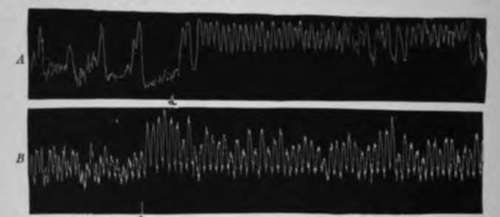II. Action Of Blood Of Starving Animals On The Gastric Hunger Mfechanism Of Normal Animals
Description
This section is from the book "The Control Of Hunger In Health And Disease", by Anton Julius Carlson. Also available from Amazon: The Control of Hunger in Health and Disease.
II. Action Of Blood Of Starving Animals On The Gastric Hunger Mfechanism Of Normal Animals
Direct transfusion from the starved donor to the normal recipient by direct union of blood vessels is not feasible, because if this is done under general anesthesia, the anesthetic itself depresses the stomach, and if it is done with aid of local anesthesia only the recipient is so disturbed that the stomach is inhibited reflexly. But we found that good-natured and gentle dogs used to our routine of recording the gastric hunger contractions were practically not disturbed at all by the puncture of the saphenous vein with a sharp needle and the injection of 20 to 50 c.c. fresh-drawn and defibrinated blood. This technique was therefore adhered to. In the preliminary training of these dogs the animal's legs were handled in various ways (shaved, injection of salt solution, etc.), so that the animal finally paid little or no attention to the handling of the leg or the insertion of the needle into the vein. In some cases we decreased the sensitivity of the skin over the saphenous vein by the application of carbolated vaseline.
The intravenous injection of 20 to 50 c.c. of fresh defibrinated blood from starving dogs into normal dogs increases the gastric tonus and hunger contractions of the latter, if their stomachs are empty and if moderate tonus and hunger contractions are in evidence in the recipient at the time of the injection of the blood. If the stomach of the recipient, although empty of food, is atonic and hunger contractions are completely absent at the time of the injections, the blood from starving animals has practically no action on the stomach. The stimulating action of this blood on the stomach already in moderate tonus and hunger contractions lasts from 10 to 30 minutes, depending on the quantity of starved blood injected.
The foregoing conclusion is based on 25 experiments on 4 gastric-fistula dogs. The blood for the transfusion was drawn from animals after 5 to 12 days of starvation.
Fig. 27.-Tracings from the empty stomach of dogs. A. at an intravenous injection of 35 c.c. blood drawn from a dog on the eighth day of starvation; showing stimulation of the gastric hunger apparatus, in the change from type I to type III hunger contractions (hunger tetanus). B, at an intravenous injection of 20 c.c. of blood from a dog in pancreatic diabetes; showing stimulation of the gastric hunger mechanism (Luckhardt and Carlson).

The failure of starved blood to induce tonus and hunger contractions in atonic and quiescent stomachs is probably due to the fact that by the present method of transfusion it is not possible to introduce enough starved blood to overcome the inhibitory factors responsible for the atonic and quiescent condition.
Continue to:
- prev: Chapter XIII. The Chemical Control Of The Hunger Mechanism. I. Analysis Of The Problem
- Table of Contents
- next: III. Effects Of Blood From Diabetic Animals
